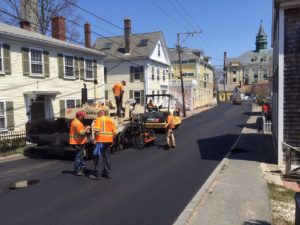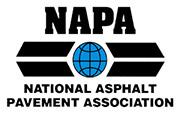Asphalt Paving Safety – Traffic Signs & Pavement Markings
Asphalt Paving Safety – Traffic Signs & Pavement Markings
 Between 1890 and 1925, driving was quite an experience. For many years, there were no laws requiring drivers to prove their competency, signs were practically nonexistent, signal lights had yet to be invented and even children were allowed to drive. As you might expect, chaos ruled the roads. In a two-month period in the summer of 1908, car crashes in the city of Detroit killed 31 people and injured so many that it became impossible for officials to track them all. Cities with cable cars running down the middle of busy streets became hazardous for riders who had to start dodging automobiles the minute they stepped off the cable car. In 1924, 23,600 deaths and 700,000 injuries resulted from automobile accidents in the United States — and there were scarcely more than 15 million cars registered in the entire nation.
Between 1890 and 1925, driving was quite an experience. For many years, there were no laws requiring drivers to prove their competency, signs were practically nonexistent, signal lights had yet to be invented and even children were allowed to drive. As you might expect, chaos ruled the roads. In a two-month period in the summer of 1908, car crashes in the city of Detroit killed 31 people and injured so many that it became impossible for officials to track them all. Cities with cable cars running down the middle of busy streets became hazardous for riders who had to start dodging automobiles the minute they stepped off the cable car. In 1924, 23,600 deaths and 700,000 injuries resulted from automobile accidents in the United States — and there were scarcely more than 15 million cars registered in the entire nation.
Asphalt Paving Safety – Traffic Signs & Pavement Markings
In the early days of the automobile, there were no lane markings, warning signs or stop signs. The first signal light was not installed until 1914, and in 1930, there were still more than 10 states that did not have any laws governing speed limits. Cities and businesses made no provisions for parking, so drivers often just stopped their cars in the street in front of their destination, blocking streets for hours.
The early years of the automobile offer insights into the problems that modern drivers would experience if every traffic sign, stop light and pavement marking were to suddenly disappear. Mayhem would prevail in parking lots and on the roads. However, you may be wondering what pavement markings and traffic signs are necessary to improve safety — and to shield yourself from potential lawsuits if someone incurs an injury or vehicle damage on your property.
Important Signs and Pavement Markings
Drivers need to know what the rules are, be warned of potential dangers and be given the information that they need to navigate. Some signs are not optional; stop, lane use, one-way, speed limit and yield signs belong in this category. Other markings and signs warn drivers of upcoming hazards, including speed bumps, curves, intersections, merging traffic, pedestrian crossings and lane transitions. Directional arrows and no-parking signs help convey the rules. Parking lots need to have all spaces clearly marked, including those that are reserved for ADA-compliant parking. In some instances, both signs and pavement markings are needed or advisable. In other situations, a sign may be sufficient on its own. For example, safety in a school zone can be increased by using both signs and pavement markings, but signs are usually sufficient to warn drivers that there is a curve ahead.
Some markings and signs are required by law. For example, your parking lot needs to be ADA-compliant. In other cases, local or state ordinances may determine which markings and signs are needed. Because the issue of traffic signs and pavement markings can be quite complex, it is always advisable to consult an experienced, reputable contractor.
If You Need a Paving Professional, Contact Dirtworks
Dirtworks is a paving company and we have the experience and knowledge to ensure that your parking lot has the markings needed to meet all state and local requirements. We offer a variety of services, including parking lot striping, pavement markings, asphalt sealcoating, asphalt repairs, asphalt paving, site work, excavation services and snow removal. We are a locally owned company with more than 20 years of experience. Our reputation has been built on the quality of our customer service, our outstanding workmanship and our competitive prices. If you have more questions about Asphalt Paving Safety – Traffic Signs & Pavement Markings or would like to request a free estimate, you can reach us at 508-240-5541 or submit the online form.
Dirtworks is an asphalt paving company servicing the counties of Barnstable, Plymouth, and Norfork.
Recent FAQs






